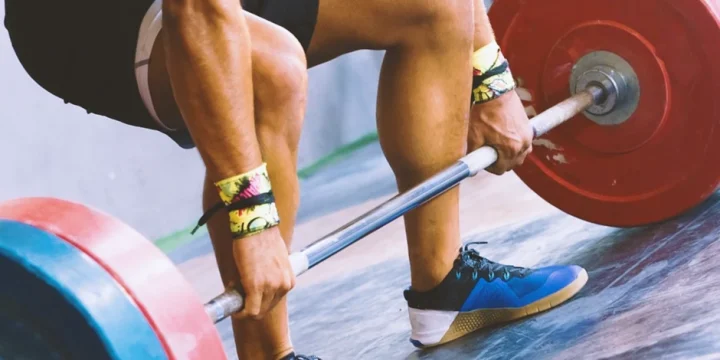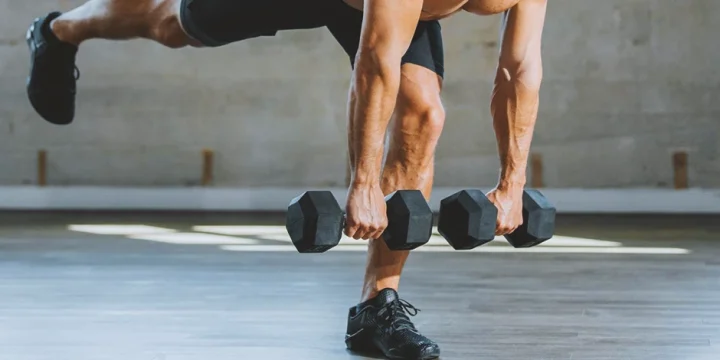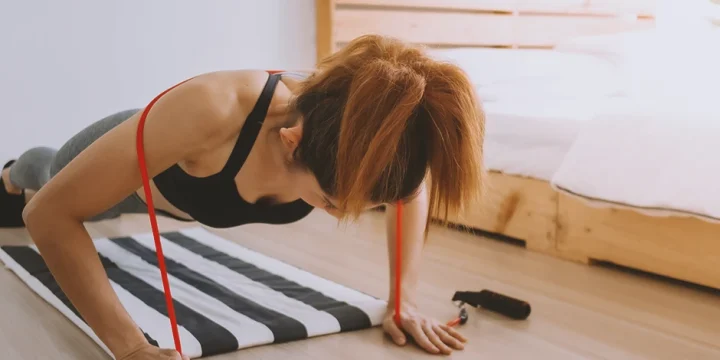The deadlift is a compound lift that targets the posterior chain, including the erector spinae, glutes, and hamstrings, and engages the forearms and traps. Adding resistance bands to deadlifts is a way to start progressive overload.
Through our trial-and-error and quite a few days of research, we discovered that these workouts could significantly enhance both intensity and exercise efficacy while challenging muscles across the entire range of motion.
Check out our insights based on personal trainer experiences if you're looking to boost your deadlift performance and achieve a more balanced and powerful physique.
Quick Summary
- The resistance band deadlift is a versatile exercise that replicates the benefits of a barbell deadlift, targeting primary muscles like glutes and hamstrings and secondary muscles including quadriceps and the upper back.
- This exercise is particularly beneficial for those recovering from injuries, as it offers a safer, more controlled form of deadlift that can be performed anywhere.
- A study from ResearchGate indicates that using bands in lifting helps maintain correct form, thereby lowering the likelihood of sustaining injuries.
- From my perspective, the resistance band deadlift is a valuable tool for muscle and strength development, and it provides an excellent foundation for beginners to learn and perfect the proper technique of deadlifting.
How to Do Resistance Band Deadlifts

In my training sessions, I often show clients how to do resistance band deadlifts by either strapping bands to their weights or using them as an alternative to bars or dumbbells, and then follow the traditional deadlift motion.
Here's how to perform resistance band deadlifts properly:
- Lay a basic looped resistance band on the floor and stand on it with your feet hip-width apart, ensuring the band is centered under your feet.
- With a straight back and engaged core, hinge at the hips and bend your knees while holding the band’s end.
- Push through, straighten up, and drive your hips forward while squeezing your shoulder blades together.
- Keep your core tight and back straight at the top, being cautious not to overarch the lower back.
- Control the descent through hip flexion, allowing a minor knee bend as you return to the starting position.
Resistance Band Deadlift Variations

Here's a list of resistance band deadlift variations to incorporate into your workout regimen:
Suitcase Deadlift
The suitcase deadlift targets core stability while fortifying the obliques and lower back, resembling hoisting a suitcase.
How to perform:
- Place a resistance band flat on the floor, standing on it with feet shoulder-width apart.
- Keep your back straight, bend your knees, and take the band's ends with your hands at your sides as if holding suitcases.
- Engage your core and push to stand upright.
- As you stand, avoid rounding your shoulders or back.
- Lower back down slowly and in control, keeping the band tense.
Romanian Deadlift
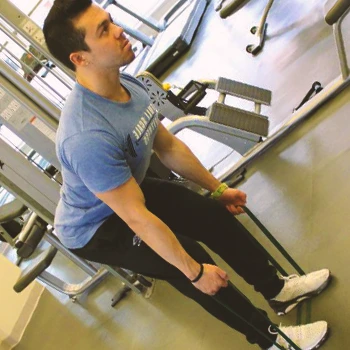
In my experience, I've found that the resistance band Romanian deadlift really targets the hamstrings and glutes, which is great for promoting hip stability and enhancing posterior chain strength.
How to perform:
- Stand on the resistance band, feet hip-width apart.
- Keep a slight bend in your knees and hinge at the hips to grasp the ends of the band.
- Maintain a straight back as you lift the band by extending your hips and standing straight.
- Squeeze your glutes at the movement's top.
- Control the descent back to the starting position.
Related:
- How To Do Romanian Deadlifts: Proper Form and Technique
- Romanian Deadlift vs Deadlift: Key Differences Unveiled
- Glutes and Hamstrings Workout
Sumo Deadlift
The resistance band sumo deadlift targets the inner thighs and works for other muscle groups, offering more comprehensive lower-body training.
How to perform:
- Position yourself on a resistance band with a wider stance than traditional banded deadlifts.
- Point your toes outward and grasp the band's ends while keeping your chest up and back straight.
- Lower your body by bending your knees and pushing your hips back.
- Drive through your heels to stand back up, squeezing your glutes at the top.
- Ensure that your knees don’t cave in as you lift.
Learn More: Sumo vs Conventional Deadlift: Strength Battle Unveiled
Stiff Leg Deadlift
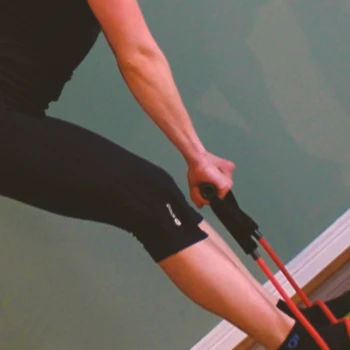
The stiff leg deadlift primarily targets the hamstrings and lower back, enhancing hamstring flexibility and improving overall posterior chain strength.
How to perform:
- Stand on the resistance band.
- Keep your legs straight but not locked, and hinge at the hips to grasp the ends of the band.
- Keep a neutral spine as you lift the band by extending your hips and standing straight.
- Squeeze your glutes at the movement's top and keep the hamstrings tension.
- Slowly lower back to the starting position.
Single-Leg Resistance Band Deadlift
The single-leg resistance band deadlift focuses on balance and coordination and strengthens each leg independently, reducing muscle imbalances.
How to perform:
- Hold the resistance band with one foot and grasp the ends of the band.
- Hinge at the hips and extend the non-working leg behind you.
- Keep your back straight and core engaged.
- Push through the standing leg to return to the starting position.
- Maintain balance and control throughout the exercise.
Barbell Deadlift
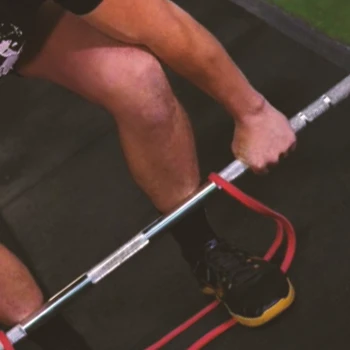
I often incorporate the barbell deadlift into my clients' routines.
It's a classic compound exercise that builds strength across multiple muscle groups, including the back, legs, and core.
Adding resistance bands to barbell deadlifts brings in variable resistance, enhancing the movement.
How to perform:
- Loop the resistance band under the middle of the barbell and stand on the band with feet hip-width apart.
- Bend at the hips and knees to hold the barbell with a grip outside your knees.
- Engage your core, keep your back straight, and lift the barbell by pushing through your heels.
- Keep the barbell close to your body as you stand up, and lock your hips and knees at the top.
- Lower the barbell back down, keeping control and maintaining a straight back.
Dumbbell Resistance Band Deadlift
Combining dumbbells with resistance bands intensifies the deadlift, engaging your upper leg and core muscles.
This variation offers both the benefits of free weights and the constant tension provided by the bands.
How to perform:
- Strap the dumbbells with a resistance band.
- Stand over the resistance band with feet hip-width apart, holding a dumbbell in each hand.
- Keeping your back straight and core engaged, hinge at your hips and lower the dumbbells toward the floor.
- Push to return to the starting position, ensuring your movements are controlled.
Banded Rack Pull Deadlift

In my training sessions, I often use the banded rack pull deadlift to focus on the upper body, especially the back muscles.
The added resistance from the band makes the lockout phase more challenging, which, according to a study from ResearchGate, is perfect for clients looking to improve their deadlift strength [1].
How to perform:
- Attach a resistance band to the barbell on a rack.
- Stand with your feet shoulder-width apart, bending at your hips and knees.
- Grip the bar firmly and, keeping your back straight, lift the bar by straightening your hips and knees.
- Lower the bar controllably back to the rack.
Banded Single-Arm and Leg Deadlift
This resistance band variation is a full-body exercise, promoting balance and coordination.
It challenges your core as you prevent your upper body from leaning forward.
How to perform:
- Stand on one end of the resistance band with one foot, holding the other end with the opposite hand.
- Keeping your core engaged, hinge at the hip of the standing leg while raising the other leg behind you.
- Simultaneously lower your arm, holding the band towards the ground.
- Return to the starting position. Repeat on the other side.
Workout Routine With Resistance Band Deadlifts

This routine will enhance your strength and stability while targeting key muscle groups:
Warm-Up
- Jumping Jacks: 2 sets of 15 reps
- Leg Swings: 2 sets of 10 reps on each leg
- Inchworms: 2 sets of 5 reps
- Bodyweight Squats: 2 sets of 10 reps
Workout Routine
- Resistance Band Deadlifts: 3 sets of 10-12 reps
- Banded Single-Arm and Leg Deadlift: 3 sets of 8 reps per side
- Stiff Leg Deadlift With Resistance Band: 3 sets of 10 reps
- Resistance Band Sumo Deadlift: 3 sets of 10 reps
Cooldown
- Walking or Light Jogging: 5 minutes
- Hamstring Stretch: 2 sets of 30 seconds on each leg
- Child’s Pose: Hold for 1 minute
- Lower Back Twist Stretch: 2 sets of 30 seconds on each side
“Performing the deadlift with band-assisted variable resistance increases bar power and velocity while concurrently decreasing muscle activation of the posterior chain musculature.”
- Jonathan Hughes, Cardiff School of Sport
Why Should You Combine Deadlifts with Resistance Bands?
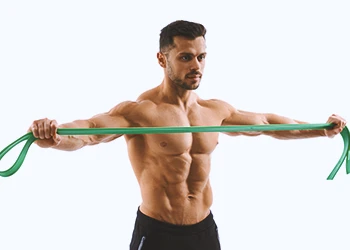
You should combine deadlifts with resistance bands to add resistance and build functional strength.
These props also help you target other muscles without adding more weight or practicing dangerous motions usually associated with a conventional deadlift.
According to a study from ResearchGate, the bands encourage maintaining proper form throughout the lift, which reduces the risk of injury [2].
Benefits of Deadlift with Resistance Band

Resistance band deadlifts have more range of motion than traditional deadlifts.
But that’s not the only benefit:
- The added tension helps activate more muscle groups.
- They boost the training of the body to maintain good posture.
- The added band resistance leads to increased muscular strength over time.
- The bands’ tension helps improve the mind-muscle connection, essential for muscle growth.
- Resistance bands are lightweight and easily carried around, making it convenient to work out anywhere.
What Are the Muscles Trained?

Deadlifts with resistance bands effectively engage different muscles, such as:
- The Glutes: Primary muscles worked in deadlifts.
- The Hamstrings: Essential for knee flexion and hip extension during the movement.
- The Erector Spinae: Supports the spine and helps maintain an erect posture.
- The Latissimus Dorsi: Engaged when you pull the band upwards.
- The Quadriceps: Involved in extending the knee and stabilizing the movement.
- The Trapezius and Rhomboids: Stabilize the upper back and shoulders throughout the exercise.
- The Forearms: Trained while gripping the resistance band, which is essential for a stronghold.
- The Core: Engaged throughout the movement for stability and support.
Resistance Band Deadlifts with Plyometric Exercises
Combining resistance band deadlifts with plyometric exercises creates an effective workout for boosting power and explosiveness.
- Start with resistance band deadlifts to activate and strengthen the posterior chain, focusing on slow, controlled movements. This exercise builds foundational strength and muscle memory.
- Transition to plyometric exercises like jump squats or box jumps, which utilize the explosive power of the lower body. These movements improve fast-twitch muscle fibers, crucial for explosive strength.
Alternating between the controlled tension of band deadlifts and the dynamic intensity of plyometrics ensures a balanced approach, enhancing overall power and reducing injury risk.
FAQs
Can Resistance Bands Substitute Weights in My Deadlift Workout?
Yes, resistance bands can substitute weights in deadlift workouts. They provide variable resistance, which emulates heavy weights.
How Do Resistance Bands Enhance Deadlift Exercises?
Resistance bands enhance deadlift exercises by providing progressive tension, helping to target different muscle groups, and improving the range of motion without putting excess strain on the body.
How Can Resistance Bands Contribute to My Deadlift Training?
Resistance bands contribute to deadlift training by allowing for muscle activation throughout the entire movement, increasing flexibility and endurance, and adding variety to the workout, which prevents plateaus.
References:
- https://www.researchgate.net/publication/335698237
- https://www.researchgate.net/publication/365297190
About The Author
You May Also Like
